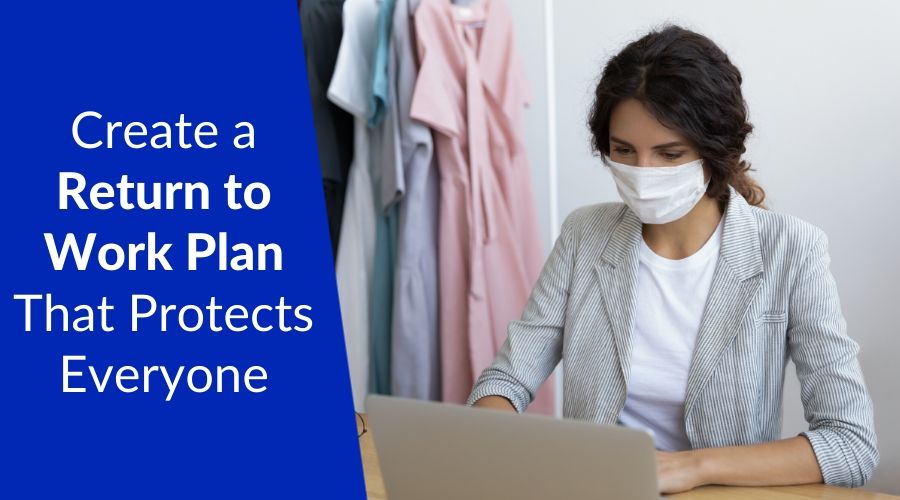
Many people are still working remotely with no set date to return to the office or production site. But companies everywhere are working hard to plan for the return of employees to the workplace. To do so, businesses create risk models to envision certain scenarios, get input from HR teams and management, and rely on employee feedback, in order to create a return to work plan.
As we see some lifting of stay-at-home orders and loosening restrictions for non-essential businesses. What does that mean for your COVID-19 recovery planning?
I’m sharing three key considerations you need to be aware of before you reopen the workplace doors.
-
You have a duty to provide a safe and healthy workplace
Depending on the federal, state and local laws where you live, you’ll have to ensure compliance with mandated protocols. For example, employers in Kentucky and Texas need to establish processes to screen employees for COVID-19 before they can return to work, but lots of other states don’t have such rules in place.
Some of the new protocols you might be recommended or mandated to implement as part of your return to work plan are:
- Regular deep cleaning and sanitization of the office, from bathrooms to communal kitchens. Don’t make the assumption that your cleaning service knows exactly what is needed; meet with them and ask specific questions.
- Moving workspaces to put distance between employees’ desks.
- Changing staff schedules to reduce the number of people in the building at one time.
- Creating guidelines around personal protective equipment (PPE) or temperature checks so employees are aware of their rights and responsibilities.
- Staggering lunches and breaks to minimize exposure.
- Relaxing attendance rules and encouraging employees to stay home if they have a fever or feel sick.
Not sure what to do? Hiring a professional HR consultant is the best way to make sure you’re meeting all requirements. A few regulatory bodies that can also provide guidance include:
- The Occupational Safety and Health Administration. The Occupational Safety and Health Act of 1970 (OSHA) was created to establish safe and healthy working conditions for US employees. During the pandemic, OSHA established standards around things like the use of gloves and masks, and documentation around keeping employees safe from hazards that could lead to injury or death.
- The Centers for Disease Control. For example, the CDC is recommending that employers encourage sick workers to stay at home, and to be flexible with sick time and time off.
-
Listening to your employees is essential
If you simply unroll a return to work plan, employees aren’t going to automatically buy into it. There may be pushback or even legal repercussions if you haven’t followed the law or considered all staff.
And while some employees may be eager to get back to the workplace, others could be nervous. For instance, they have health conditions that increase their risk of infection or don’t have childcare yet.
Even employees who do come back will need time to adjust, especially if their schedule has changed or the layout of their workspace is different.
So how can you help with the return of employees to the workplace?
- Make sure everyone knows what’s expected of them, and the workplace policies they need to follow.
- Be transparent about any changes you’re making and why. Have an open door policy that allows employees to ask questions.
- Use employee surveys to measure your workforce’s comfort around returning to work.
- Be as flexible as possible to people’s unique needs. For instance, they might be covered under the American’s With Disabilities Act and if so, you need to consider making reasonable accommodations.
I’ve also previously shared some tips on managing your remote employees—now and during COVID-19 recovery planning
-
Protect yourself legally.
Part of the problem is that there isn’t a lot of legal information around businesses reopening after the coronavirus pandemic. We’ve already seen a few lawsuits, like the family of a Walmart employee who died of COVID-19 complications filing a wrongful death lawsuit against the company.
Here’s another example. A medical billing service has been accused of violating the Families First Coronavirus Response Act (FFCRA) by denying paid leave to an employee who was under doctor’s orders to self-quarantine after experiencing COVID-19-like symptoms.
Under the FFCRA, employers with fewer than 500 employees must provide up to 12 weeks of paid sick leave plus expanded family and medical leave at two-thirds of their regular pay to eligible employees. Employers with fewer than 50 employees may be exempt from providing leave when the imposition of the requirements would jeopardize the viability of the business as a going concern.
We can expect these types of pandemic-related lawsuits and grievances to continue as employers navigate murky waters. Because there’s no precedent to refer to, businesses need to proceed with incredible caution or risk costly and time-consuming legal issues. Are you prepared?
As organizations take on COVID-19 recovery planning with employee health and safety and laws and regulations in mind, it’s crucial to have the right HR support. I can help you create a return to work plan that covers all the legal, health and safety bases. Contact me to get started.
Business Leadership, Business Management, Team Management